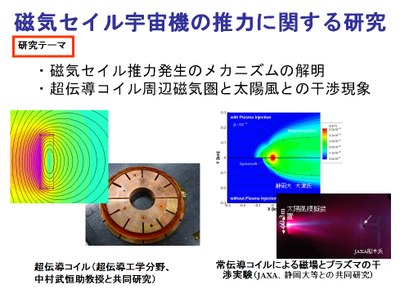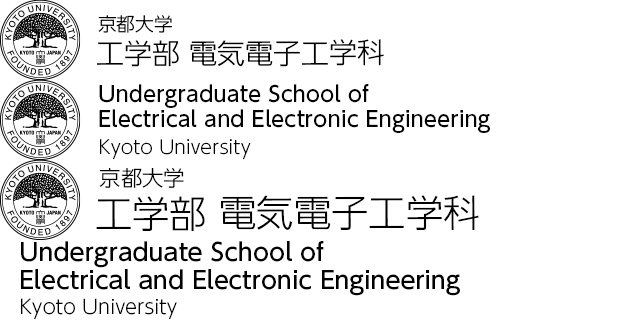Space Radio Engineering (Space Systems and Astronautics/Yamakawa Lab)
At the Yamakawa Lab, we conduct research, from the perspective of both engineering and science, aimed at understanding the electromagnetic environment of outer space and exploring space systems necessary for making use of this environment as human living spaces. This field of research covers a wide range of activities—from space systems engineering, orbital dynamics, and space plasma physics, to electronic engineering and radio engineering. In addition, this lab is deeply involved in both Japan and overseas-based space missions and in promoting research initiatives in partnership with the Japan Aerospace Exploration Agency (JAXA), the National Aeronautics and Space Administration (NASA), the European Space Agency (ESA), and many scientists from Japan and overseas.
Academic Staff
Hiroshi YAMAKAWA
 Professor (Research Institute for Sustainable Humanosphere)
Professor (Research Institute for Sustainable Humanosphere)
Research Topics
- Space Environment
- Space Engineering
- Astrodynamics
- Space Radio Engineering
- Space Radio Science
Contacts
TEL: +81-774-38-3805
FAX: +81-774-31-8463
E-mail: yamakawa (at) rish.kyoto-u.ac.jp
Hirotsugu KOJIMA
 Associate Professor (Research Institute for Sustainable Humanosphere)
Associate Professor (Research Institute for Sustainable Humanosphere)
Research Interests
- Development of plasma wave instruments onboard scientific spacecraft
- GEOTAIL spacecraft(Terrestrial Magnetosphere, Launch: 1992)
- BepiColombo (Marcury magnetosphere, Launch: 2013)
- Development of the Wave-Particle Interaction Analyzer
- Development of Small-size plasma wave instruments using the ASIC technology
- Observations of plasma waves in space via spacecraft
- Analyses of nonlinear plasma wave phenomena
- Study of magnetospheric dynamics via plasma wave features
- Study of electric field antennas characteristics in space plasmas
- Stud of the Monitor for Space Electromagnetic Environments (Sensor Network in Space)
- Developmnt of the small sesor node based on the ASIC technology
- Study of the location estimation method of scattered esnsornode
Contacts
RISH, Kyoto University, Gokasho, Uji, Kyot 611-011 Kyoto Japan
TEL: +81-774-38-3816
FAX: +81-774-38-3816
E-mail: kojima rish.kyoto-u.ac.jp
Yoshikatsu UEDA
 Assistant Professor (Research Institute for Sustainable Humanosphere)
Assistant Professor (Research Institute for Sustainable Humanosphere)
Research Theme
- Remediation/Cleanup technologies of Radioactive Contamination for Support Fukushima. (福島県下における土壌・水質汚染の実地調査と、放射性核種の高速除去技術の実証研究)
【1.事業の概要】
本事業は、生存圏研究所及び化学研究所の連携により、福島原発近郊(避難区域以外の比較的汚染度の高い地域)にて実際に放射性セシウムで汚染された土壌の効率的な除染技術、及び、農作物への低吸収技術の提案を目的とした事業である。 本申請チームでは、福島県農業総合センターと緊密に連携し、実際の汚染土壌を用いて技術の実証研究を行う。申請者らのうち上田・徳田は昨年度、総長裁量経費の支援の下、ナノバブル水を用いて放射性セシウム汚染を除染する技術の検討を行ってきた。本申請では、第191回生存圏シンポジウム「東日本大震災以後の福島県の現状及び支援の取り組みについて」における議論とこれまでの研究成果を踏まえ、昨年度の申請を発展的に展開し、福島県農業分野の復旧・復興への貢献に軸足をシフトする。具体的には、上田・徳田によるナノバブル水による除染技術と、伊藤・杉山による蛍光X線を利用した高分解能蓄積部位解析を統合的に活用し、福島県農業センターとの緊密な連携の下で支援事業を行う。
【2.事業の実施方法】
1)ナノバブル水を用いた除染技術の実証と植物生育促進効果の検証(上田義勝・徳田陽明) ナノバブル水による除染効果は実証済みであるが、その除染メカニズムは不明な点が多い。そこで、セシウム除去におけるナノバブル水の効果を定量的(粒子分布・電気伝導度等の測定)に検証し、除染の最適化を目指す。また、ナノバブル水には花き植物の延命効果や生育促進効果もあるといわれている。さらに、ナノバブル水の生育促進効果は水耕栽培を行う植物工場での利用も期待されている。そこで、項目2)の水耕栽培系においてナノバブル水の効果(根の養分吸収、生育、収量、品質等)を検証し、植物栽培におけるナノバブル水の効果を同様に定量的に明らかにし、福島県の農業再生の支援を行う。する。 2)蛍光X線を利用したセシウム吸収部位の高分解能解析と低吸収栽培技術の確立(伊藤嘉昭、杉山暁史) X線分析顕微鏡による蛍光X線分析は、10μmの分解能で植物体内での元素の蓄積部位を調べることができるため、組織間でのセシウム蓄積能力の比較解析に極めて有効な方法である。また、特別な前処理を必要とせず、生きたままの状態で植物を分析できるという利点もある。食の安心・安全へ向けて、可食部のセシウム移行が少ないイネやダイズ品種の水耕栽培を用いたスクリーニングや施肥条件の検討、及びナノバブル水の効果について検証する。
【3.本学の発展に期待される効果】
生存圏研究所の理念は、「社会的な要請を背景にして人類の生存と繁栄を脅かす諸問題の解決に取り組む事」であり、未曾有の原発災害からの福島県農業の復興を目的とした本事業に最優先で対処していくことは必須である。本申請では、生存圏研究所、化学研究所の4名の教員が福島県農業総合センターと連携して本格的に福島県の農業復興に取り組む重要な研究事業であり、震災復興において本学が果たすべき社会的な役割の一端を担うものと信じる。
- Electrochemical property of Nanobubbled water and its applications. (ナノバブル水の電気化学特性の研究とその応用利用に関する研究)
- 観葉植物の延命効果
ナノバブル水には花き植物の延命効果や生育促進効果もあるといわれている。さらに、ナノバブル水の生育促進効果は水耕栽培を行う植物工場での利用も期待されている。そこで、水耕栽培系においてナノバブル水の効果(根の養分吸収、生育、収量、品質等)を検証し、植物栽培におけるナノバブル水の効果を同様に定量的に明らかにする。 - Removal Cesium (除染利用)
The Fukushima Daiichi Nuclear Power Station suffered a meltdown as a result of the Tohoku earthquake that occurred on March 11, 2011, in Japan. The accident released several kinds of radioactive nuclei over eastern Japan. Among these nuclei, Cs-134 and Cs-137 are the most important in terms of their effects on the environment. Fallout Cs is stabilized in soil by ion exchange with alkali ions and is well-known to be difficult to remove. Indeed, a previous study employing phytoremediation failed to remove radioactive Cs from the soil. Furthermore, although another trial using strong acid and/or chemicals was successful, such chemicals may themselves be environmental pollutants because they alter the pH of soils and the composition of inorganic ions, which strongly influence plant and animal growth. Thus, a more benign approach to remediation is required. Here, we report the effectiveness of using water containing nano-sized air bubbles with a diameter around 100 nm (nanobubbled water) on removal of radioactive Cs. Nanobubbled water was effective for removal of radioactive Cs from granule conglomerate in Fukushima, Japan. Although the characteristics of such water are not completely understood, it is currently used on Japanese highways to remove de-icing salts.
福島原発災害により、放射性セシウムが東日本に降下した。我々はセシウムの除染にナノバブルを含む水(ナノメートルオーダーの気泡を含む水)が有効であることを既に見いだしている。しかしながら、ナノバブルを含む水による放射性セシウムの除去機構については不明である。本研究ではナノバブルを含む水の粒度分布、各粒子の表面電荷密度を種々の方法によって解析し、除染効率との相関を明らかにする。得られた知見を元に除染効率の向上や、無機イオンを含むナノバブルを含む水の生成を試みる。また、福島県下にての除染の実証試験を行って、現地に即した除染方法の提案を行う。 - 材料合成
大気汚染や水質汚染は、生活圏を脅かす問題であり、種々の解決策が提案されている。その一つとして、チタニアに代表される光触媒の利用がある。その中でも、高機能化、省資源化、低環境負荷の観点から、ナノ粒子に注目が集まっている。本研究では、種々のナノ粒子を作製する新規な手法を探索し、生存圏科学に資する材料を作製することを最終的な目標とする。 さて、マイクロメーターオーダーのサイズの泡を含む水は、マイクロバブル水と呼ばれており、特異な物理化学的挙動を示すことが知られている(500 nm以下程度の泡を含む場合に、ナノバブル水と呼ばれる)。バブル表面が負に帯電しているため、バブル同士の静電反発によって、長時間消滅しないことや、表面張力が低下することなどが知られている。また、バブル圧壊時に、衝撃波が発生することなども、実験的に明らかとなっている。尚、このマイクロバブル水は生存圏研究所所蔵の装置BuvitasHYK-32-Dを用いることで生成が可能である。 水に超音波を照射すると、局所的な水の粗密に由来するバブルが生成することが知られている。このバブルの圧壊に由来するエネルギーによってラジカルが発生するため、超音波を材料合成に利用するという試み(ソノケミストリ)がなされてきた。この超音波によって作り出された反応場は、結晶軸配向、結晶成長速度の増加という効果を生み出す。 マイクロバブル水においても、超音波照射と同様にバブル圧壊に伴うラジカル発生するとされており、特異な反応場を生み出す可能性がある(図1)。また、マイクロバブル水の大まかな特性は、純水と同じであるので、超音波照射下では一般的に容易ではない、高温下、高圧下といった反応条件を用いることもできる。さらに、表面張力が低下することを利用すると、界面活性剤を用いることなく、水と有機溶媒を乳化させることも可能である。このようにマイクロバブル水を出発原料とする材料合成は、新規な反応場を生み出しうる萌芽的な研究であるといえる。 本研究では、環境触媒材料であるアナタース型の酸化チタン(TiO2)のナノ粒子を高効率に作製することを試みる。具体的には、水を用いるゾルゲル法に着目し、出発原料としてマイクロバブル水を用いることによって、低温度での結晶化、高効率(高い結晶成長速度)な反応を試みる。 - Electrochemical property about proton conductive material (高機能材料(プロトン伝導性素材)の電気化学特性の解析)
Further advances in polymer electrolyte fuel cells require membranes which can operate at intermediate temperatures (100–150 °C). In this study, we have prepared novel organic–inorganic hybrid titanophosphite membranes possessing proton conductivity. Ethanol condensation of vinylphosphonic acid (VPA) and titanium tetraisopropoxide, followed by successive copolymerization with ethylmethacrylate monomer afforded the desired titanophosphite membranes. The obtained membranes are crack-free, water durable, and thermally stable up to 200 °C. IR, NMR, and UV-vis analyses reveal that the membranes have graded monomer conversion from the top surface to the core due to UV absorption of titanate during photopolymerization; the intensity of UV light during photopolymerization decreases as the penetration depth increases, resulting in a decrease of conversion of the inner part. The surface of the membranes are completely polymerized, affording water durability, whereas the inner parts are partially polymerized, allowing VPA to act as a proton donor. This provides proton conductivities as high as 6.3 × 10-4 S cm-1 at 130 °C under a nitrogen atmosphere. These properties overcome the well-known problem that proton conductivity of polymer electrolytes decreases at intermediate temperatures.
エネルギー供給の多様化や地球温暖化問題の解決のため、燃料電池への注目が集まっている。プロトン交換膜型の燃料電池の高効率化のためには100℃以上の中温領域での作動が不可欠である(白金触媒の被毒を避けるため)。本研究では、表面で耐久性を保持し、内部でプロトン伝導性を示すような傾斜機能性を有する有機・無機ハイブリッド膜の新規な合成法を考案し、中温・無加湿下で作動するプロトン伝導膜の高機能化を行う。 共同研究者らは、無溶媒下でのアルコール縮合を利用して、バルクサイズの有機-無機ハイブリッド膜を得る方法を考案した。得られたケイリン酸塩系有機-無機ハイブリッド膜は、リン酸基(POH)を多く含み、中温領域での高いプロトン伝導性が期待でき、昨年度の生存圏ミッション研究により、510-3 S/cm@85Cという比較的高いプロトン伝導性を示す事がわかった (Tokuda et al., J. Mater. Res. 2011、Tokuda et al., Solid State Ionics 2012)。さらに光重合時の紫外光阻害を利用して重合率を膜厚方向に傾斜させたチタノリン酸塩系有機無機ハイブリッド膜は、プロトン放出サイトを内部に保持し、かつ表面が完全重合層となって耐久性を確保できるような、新規な合成プロセスを見いだした。 本研究では、有機・無機ハイブリッド材料の化学的耐久性と柔軟性を併せ持つプロトン伝導膜を作製することを最終目的としている。プロトンが膜を伝達するためには、分子レベル、マイクロ構造レベル(伝導パスの存在)での構造制御が不可欠である。さらにマクロ構造レベルでの構造設計により目的を達成する。 - Study for space applications of R-type manganese dioxide (R型二酸化マンガンを用いた宇宙利用への応用システムの研究)
- 燃料電池特性 Specifications to fuel cell
低炭素社会の実現に向けた水素エネルギー利用に関する研究開発は非常に重要な研究課題である。二酸化マンガンはMnO2の化学組成をもち、電池材料として一般にもよく知られた物質である。ところが、二酸化マンガンの結晶構造にはアルファ型、ベータ型、イプシロン型、ガンマ型、ラムダ型、デルタ型、アール型と7種類の異なる結晶構造が存在し、それぞれの結晶構造毎に、導電性やイオン交換性など多くの物理・化学的性質が全く異なるという事実は、無機材料の専門家の間でもあまり知られていない。近年、SPring-8に代表される放射光施設や中性子利用施設の高性能化が進み、従来、充分な解析が困難であった二酸化マンガンにおいても局所的な結晶構造の違いを解析することが可能になってきた。その結果、アール(R)型結晶構造を有する二酸化マンガンのナノ粒子(RMO)が酸化物であるにもかかわらず、室温下においてプロトン伝導性を示し、電気的特性が他の結晶構造と比較して異なる事が明らかにされつつある。本研究は、RMOに特有の電気特性を利用することで、従来の固体酸化物とは温度領域の異なる、室温動作型の燃料電池システムの開発を目指すものである。我々の研究グループでは、RMOナノ粒子を用いた電気特性の解析を2007年度よりすすめており、そのプロトン伝導性に着目して解析を行ってきた。RMOの水素ガスに対する基礎特性解析として、RMOのナノ結晶粉末を直径2cmのペレット上に圧縮加工し、白金メッシュで挟み込む事で、常温(約25℃)下における水素ガスの濃度依存性について計測したところ、反応域が0.1%~99.9%と広範囲の濃度領域に対して起電圧反応特性が得られる事が判明した。その特性傾向を較正値とした水素ガスセンサを我々は既に開発済みであり、新聞発表も行っている。また、RMOは結晶構造的に100℃以上の中温域下においてプロトン伝導特性が向上する事がわかっており、燃料電池的な性能も持つ事が分かりつつある。そのため、これまであまり使用されていない温度域(100℃から300℃程度)での新しい酸化物型燃料電池材料としても期待されつつある。本研究においては、まず基礎特性計測として、各結晶構造におけるマンガン材料の水素ガス反応特性を発電特性として精査・測定した。その測定から、RMOが燃料電池材料としてマンガン結晶の中では一番最適な特性であることが判明したため、その詳細について開発した水素ガスセンサの紹介とともに温度特性、インピーダンスプロットなどの電気化学特性比較を行った。 - 水素ガスセンサ Hydrogen sensor development
A high-purity, ramsdellite-crystal type manganese dioxide was used for an electrolyte in a hydrogen gas sensor. In this report, the electrochemical properties of the hydrogen gas sensor using electrolytes made of different crystal type of manganese dioxides, such as the ramsdellite-crystal type, a β-crystal type, and a λ-crystal type were examined. The high-purity, ramsdellite-crystal type manganese dioxide showed the electrical conductivity from 0.71 x 104 to 1.69 x 104 S/cm between 25 and 80˚C under 85 % relative humidity (RH) condition. This conduction was mainly based on unique proton conduction on the surface of the particles.
水素は代表的なクリーン・エネルギーであり、その安価な製造方法に対する市場ニーズが今後ますます高まることは必須な状況である.現在、水素の主な製造方法として、天然ガスの主成分であるメタンガスに700-800℃の水蒸気を接触させて水素に改質する方法がとられている.しかしながら、この方法ではメタンガスから水素へ80%以上の高い変換効率は得られる反面、高温の水蒸気を製造するコストが高く、水素の低価格化は望めない.このため、種々の触媒材料を用いることで、より低温で水素への改質が試みられている.しかしながら、アルミナを担体とした貴金属触媒では耐熱性は高いがメタンガスを水素ガスに直接変換した際に副産物として一酸化炭素COが発生してしまう.また、活性炭などのカーボン材料を貴金属触媒の担体に使った場合にはカーボン自体が数百℃で灰化する.そこで本研究では、二酸化マンガンを担体として貴金属の中でも比較的安価なパラジウムのナノ粒子を二酸化マンガンの表面に析出・担持させた触媒(Fig1参照)を用いて水素変換効率を向上させる手法を提案し、研究を行う。 - Neutron spectroscopy of hydrogen in meso-porous carbon for hydrogen gas storage application (メソポーラスカーボンに関する中性子ビーム・電気化学を用いた特性解析)
We developed a simple synthesis of a meso-porous carbon produced by using novel flash heating method, which combines a high porosity of over 98.5% with a high Brunauer–Emmett–Teller surface area of 677.7m2/g. The products consisted of cross-linked carbon beams containing surface micro-pores (pore size < 2 nm) and meso-pores (5 nm < pore size < 50 nm). In addition, macro-pores (5 m < pore size < 50 m) were found between the cross-linked carbon beams (see Fig. 1). The electric conductivity of the material was lower than 2.9 x 10-3Ω・m
国内外における木質材料粉末は販売されている物もあるが、廃棄されている材も多く、その有効利用についての議論が活発に行われている。本研究では、準密閉容器内でその木質粉末を急速加熱して液化・再凝固させることで、従来のカーボン材料とは異なる新規な多孔質カーボンを精密に合成する研究を行う。この多孔質カーボンは穴径が一定で表面積も広く、昨年度の生存圏研究所部局活性化経費(若手研究者の競争力強化に関する取組)による助成で行った先行研究において、その穴(4nm)において水素が特殊な状態で捕獲されている事が確認されている。本研究では、将来の萌芽的研究として、材料や生成方法の違いによる水素吸蔵性能をより詳細に調査するとともに、材料を加工してパラジウム担持させる等の処理を行う事で、その水素吸蔵性能がどこまで上がるかについて評価・研究を行う。 - SS-520-2 Rocket Experiment
宇宙空間においては、プラズマ波動を介して粒子同士の相互作用が発生すため、科学衛星観測では電界や磁界を観測するプラズマ波動観測器と、電子やイオンを計測する観測装置が個別に搭載され、観測が行われて来ている。本研究では、これらの観測機器で個別に得られたデータを衛星機上で処理することで、より高度な情報を得る事を目的とする。利点としては、衛星から地上へのデータ転送レートを気にすることなく機上で生データを全て利用出来る点であり、高精度の観測が行えると期待されている。
水星探査計画「bepiColombo」搭載プラズマ波動観測器の開発
http://www.jaxa.jp/projects/sat/bepi/index_j.html
SS-520-2号機北極ロケット実験によるプラズマ波動観測器の開発と解析(2000年打ち上げ)
- Development of Plasma Wave Analyzer (PWA)
Data Analysis observed by PWA - 水星探査ミッション Bepi-Colombo Mission
Development of Low noise amplifier and Small & lightweight receiver - Wave-Particle Correlater (波動粒子相関計測器の開発)
- 1-chip type micro plasma wave receiver (1チップ型波動粒子計測器の開発)
- 電磁環境モニタ装置開発
- 磁気プラズマセイル実験系・シミュレーション Magnetoplasma-sail experiment/simulation
Contacts
TEL: +81-774-38-3869
FAX: +81-774-38-3869
E-mail: yueda@rish.kyoto-u.ac.jp
Introduction to R&D Topics
Research on space propulsion systems that utilize the energy of the solar wind (high-speed plasma flow) and/or solar pressure.
Solar wind, a high-velocity plasma flow that originates from the sun, blows hard between the planets. A magnetic plasma sail is a system that captures the kinetic energy of this solar wind to provide propulsion to a spacecraft by generating an artificial dipole magnetic field around the spacecraft. Whether it is possible to make such a magnetic plasma sail in practice depends on whether the low mass and limited power resources of the spacecraft are capable of generating a magnetic field that is strong enough to capture the solar wind plasma flow. From 2005, our group, in cooperation with other researchers in Japan, has been working to verify the basic principles of magnetic plasma sails by performing numerical simulations and scale-model experiments in a vacuum chamber, for the purpose of exploring the practicability of spacecraft having such revolutionary propulsion systems. Based on the propulsion performances obtained in the results of our study, we demonstrated that it is possible to realize interplanetary flights, or even flights that escape the solar system, in less time than was previously possible. At the same time, we are performing detailed investigations on the practical details of such a spacecraft. In order to improve the precision of the system design—in relation to the mass, power, and heat control of the spacecraft—we are pursuing research and development into superconducting electromagnet systems for space use, which is a key technology for a magnetic-plasma-sail spacecraft.


Research on a space electromagnetic environment monitor (space scattered-type sensor network)
We are engaged in research aiming at the practical application of analog components of plasma wave observation instruments for installation on satellites, which our lab has developed, to the integrated circuits known as analog ASICs. In this way, it will be possible to fit components that were previously as big as a single A4-size substrate, on a square chip several millimeters in size. At the same time, we are doing R&D on a space electromagnetic environment monitor that utilizes this miniaturization technology to enable easy measurement of electromagnetic characteristics at many different points in space. This monitor system consists of small sensors, made possible by analog ASICs, and a device that controls the transmission of position detection and observation data for each of the randomly scattered measurement points. This equipment, which aims to monitor the disruption that humans will cause in the space environment when they begin activities in space, is also expected to be useful in terrestrial sensor network systems.

Research on wave-particle interaction analyzers for direct observation of energy transportation in space plasma
In next-generation magnetospheric orbiters, it will be important to observe the particle and wave energy exchange process on a time scale that is at least 1,000 times faster than current technology permits. The process of transferring observation data to the ground and performing analysis there, which has been the method employed up until now, can never be fast enough to meet this requirement, so it will be necessary to perform onboard high-velocity "wave-particle interaction analysis." This lab is pursuing the development of a digital wave-particle interaction analyzer for onboard use that enables one-chip data analysis. We are currently performing prototyping testing of this technology.

Research on the Mercury Magnetospheric Orbiter of "BepiColombo," the Japan-Europe international Mercury exploration project
Although Mercury is the closest planet to the sun, no satellite has properly surveyed the planet from a circular orbit. The only observation of Mercury up until now has been done by the US probe Mariner 10, which flew by the planet in 1974. From the results of observations from Mariner 10, it is known that Mercury has a characteristic magnetic field, though weak, which suggests that Mercury may have a magnetic field that resembles the earth's magnetic field. The "BepiColombo" Mercury Magnetospheric Orbiter, jointly developed by Japan and Europe, will be the first satellite to investigate the magnetic field of Mercury. This probe is expected to be launched by 2013. The Yamakawa Lab is involved in the systems development of the Mercury Magnetospheric Orbiter, and is also developing an onboard plasma wave observation device for the probe.


Research on the orbit dynamics and control of spacecraft
In order to realize space observation, exploration, and utilization missions by means of artificial satellites orbiting around the earth and probes that survey the moon and other planets, when planning the space mission—from the scale of the satellite to the system design—it is very important to determine what kind of orbit to position the spacecraft. Kepler's Laws and Newtonian mechanics, which were discovered in the course of trying to understand the orbits of the moon and the planets, have opened up the field of celestial mechanics over the past centuries. Now, with the new perspective of controlling the orbit of spacecraft by means of the onboard propulsion engine, this field of research has become even more extensive and exciting than simple celestial mechanics. In addition, since it is necessary to consider actual spacecraft systems, this field is expanding wider and wider, in terms of orbit dynamics and control, in accordance with advances in new observation equipment, new propulsion systems, and new power systems. In this lab, we pursue research in a wide range of areas, including solar power-based space propulsion systems—for example for outer planet exploration with magnetic sails that convert solar wind into propulsion force, earth magnetospheric exploration and planetary exploration with solar sails using solar light pressure—orbit change technology based on beam energy from remote locations using lasers and microwaves, optimization of orbits for exploring planets, minor planets, and comets, based on swingby techniques that change orbit by actively utilizing electric propulsion engines and planet gravity, orbital control of formation flights utilizing Coulomb force in orbits around the earth, and space observation orbits close to the Lagrangian point, which is the equilibrium point between gravitational and centrifugal force in the three-body problem involving the sun, the earth, and the spacecraft.


Research on mobile disaster systems having microwave power transmission function
The focus of this research is technology for simultaneous wireless transmission of electric power and data by means of microwaves. In recent years, there have been many advances in research on the use of microwaves for data transmission, e.g., Wi-Fi networks, but our intention is to investigate the addition of power transmission to this, in order to cultivate a variety of novel applications. The Research Institute for Sustainable Humanosphere has been studying ubiquitous power systems and wireless charging of automobiles as examples of terrestrial applications of this kind of power transmission. In addition, as examples of space applications for the near future, the institute has been energetically doing research on a wireless transmission system for electric power generated in a solar power station (SPS) orbiting the earth. The power generated by solar cells is converted into microwaves for transmission to the ground. We are planning to apply the results of this research to our proposed development. For the purpose of technical verification we are planning an experiment on transmitting power and data to the surface of the earth from an airship fitted with an onboard microwave transmitter.

